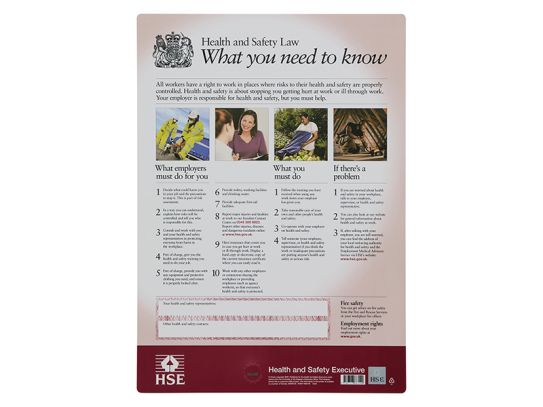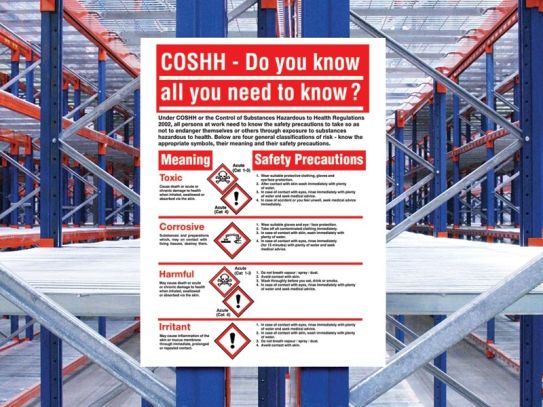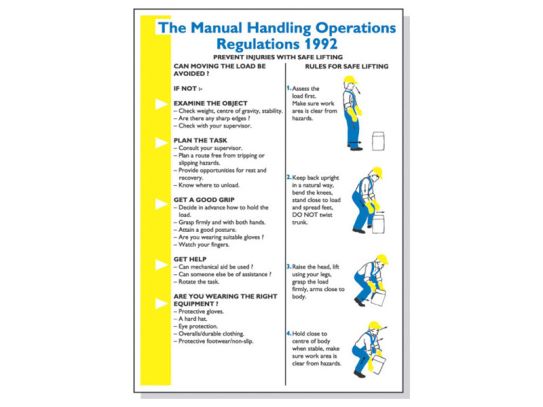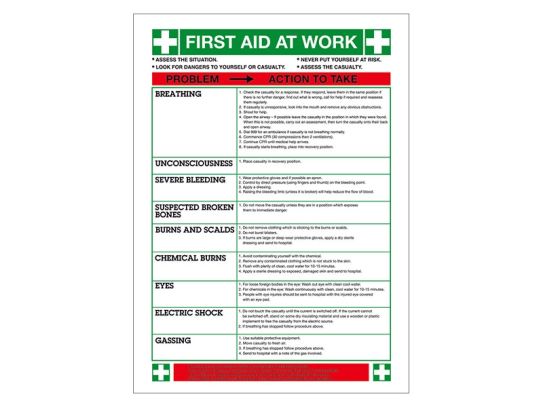Health & Safety Posters
Stay Safe and Compliant
Protect your employees and stay compliant with the law with our top-quality Health & Safety posters! From Health and Safety Law to COSHH and Manual Handling Operations, our posters cover all the essential information needed to keep your workplace safe.
Our posters are made from durable PVC, ensuring they will last for years to come, making them an affordable investment for your business. Our First Aid at Work poster is an especially important addition to your workplace, providing employees with the knowledge and tools to respond quickly and effectively in case of an emergency.
Don't wait for an accident to happen, stay on top of your workplace safety today with our comprehensive range of Health & Safety posters.
What Are Health & Safety Posters?
Health & Safety posters are visual aids that provide employees with important information and guidelines related to maintaining a safe and healthy work environment. These posters are often used in workplaces to communicate important safety information, such as emergency procedures, first aid instructions, and information about potential hazards and how to avoid them. They are typically placed in common areas where employees can easily see them, such as break rooms, hallways, and near exits.
There are a wide variety of health & safety posters available, each covering different topics. Some common examples include posters on fire safety, chemical hazards, ergonomics, and personal protective equipment (PPE). They are made to be highly visible and informative, with simple and easy-to-understand illustrations and text.
The use of Health & Safety posters is important for employers, as it can help them comply with health and safety regulations, avoid fines and penalties and ensure a safe environment for employees to work in. It also helps educate employees on how to prevent accidents and how to respond in the event of an emergency.
What Are Some Common Uses for Health & Safety Posters?
There are many different ways that health & safety posters can be used in the workplace. Some common uses include:
- Communicating safety procedures: Posters can be used to clearly communicate important safety procedures, such as evacuation plans and emergency procedures, so that employees know what to do in case of an emergency.
- Providing information about hazards: Posters can be used to inform employees about potential hazards in the workplace, such as slips, trips, and falls, and how to avoid them.
- Highlighting the importance of personal protective equipment (PPE): Posters can be used to remind employees of the importance of using PPE and how to use it properly.
- Educating employees on First Aid: Posters can be used to provide employees with important first aid information and instruction on how to respond in case of an emergency.
- Encouraging good health and hygiene: Posters can be used to promote good health and hygiene practices, such as handwashing and the use of sanitation stations.
- Compliance with Legal Obligations: Posters can be used to inform employees about the regulations and laws related to their working environment, such as health and safety laws, COSHH regulations, and manual handling regulations.
In summary, Health & Safety posters are versatile tools that can be used to communicate a wide range of information and can help employers maintain a safe and compliant working environment for their employees.
What Are the Different Types of Health & Safety Posters?
There are many different types of health & safety posters available, each focused on specific topics or types of hazards.
- Health and Safety Law: These posters provide information about the laws and regulations that employers are required to comply with in order to ensure the health and safety of their employees.
- COSHH Do you know?: COSHH stands for Control of Substances Hazardous to Health. These posters provide information about the risks associated with hazardous substances and the measures that employers should take to control these risks, including information about storage, handling and disposal.
- Manual Handling Operations: These posters provide guidance on how to safely perform manual handling tasks, such as lifting and carrying heavy objects, to prevent musculoskeletal injuries.
- First Aid at Work: These posters provide information about first aid procedures and emergency response, including information about how to perform CPR, use a defibrillator, and treat common injuries.
What Are the Key Features to Consider When Choosing Health & Safety Posters?
When choosing health & safety posters for your workplace, there are several key features to consider to ensure that they are effective and useful for your employees. Some important factors to consider include:
- Relevance: Choose posters that are relevant to your workplace and the specific hazards that are present. For example, if you work in a laboratory, you may want posters on chemical safety.
- Clarity and simplicity: Make sure that the posters are clear and easy to understand, with simple illustrations and text. This will ensure that employees can quickly grasp the information and retain it.
- Visibility: Ensure that the posters are easily visible and placed in high-traffic areas where employees can see them.
- Durability: Look for posters that are made from durable materials, such as PVC, that can withstand frequent use and exposure to the elements without getting damaged.
- Size: The poster size should be appropriate and easy to read from a distance. It should also be of a convenient size that it can be mounted easily and comfortably.
- Compliance: Make sure the posters are in compliance with the relevant laws and regulations, and keep them up-to-date with any new changes.
- Language: It's important to consider whether the employees will be able to understand the language of the posters, especially if there are employees with different linguistic backgrounds.
- Variety: A range of posters that covers a variety of topics, for example, fire safety, ergonomics, PPE, etc will be more useful than a few posters that cover only one or two topics.
By considering these factors, you can ensure that the health & safety posters you choose will effectively communicate important information and help keep your workplace safe.
Where Should I Place Health & Safety Posters?
Health & safety posters should be placed in common areas where employees can easily see them. The most effective placement depends on the specific workplace, but here are a few general guidelines:
- Break rooms: Break rooms are a good place to put posters because they are typically high-traffic areas where employees gather to take breaks and eat.
- Hallways: Hallways are another high-traffic area where employees pass through multiple times a day. This can be an effective location for posters that cover a wide variety of topics, such as emergency procedures and hazards.
- Near exits: Placing posters near exits is important for emergency procedures such as fire evacuation plans.
- Work areas: Placing posters in work areas is important for information related to specific hazards of that area.
- Meeting and training rooms: Placing health and safety posters in these places can serve as a reminder for employees about important information covered during training or meetings.
- Entry/exit points: Placing health & safety posters at entry and exit points of the building can be an effective way to remind employees to take necessary precautions as they enter and leave the workplace.
It is important to ensure that the posters are easily visible and placed in high-traffic areas where employees can easily see them. It is also important to consider the specific type of poster and the information it contains. For example, first aid posters should be placed in areas that are easily accessible in case of an emergency.
How Often Should I Update My Health & Safety Posters?
It's important to keep your health & safety posters up-to-date to ensure that the information provided is accurate and relevant. The frequency of updates will depend on the specific poster and the information it contains, as well as any changes to regulations. Here are a few general guidelines:
- Emergency procedures: These posters should be updated whenever there are changes to emergency procedures, such as changes to evacuation routes or emergency contact information.
- Hazards: These posters should be updated when new hazards are identified or when the information about existing hazards needs to be updated.
- First aid: These posters should be updated when new information becomes available or when new first aid procedures are introduced.
- Compliance: Employers should make sure that the posters are in compliance with the relevant laws and regulations and should check them periodically to make sure they are still in good condition and readable. Any changes on the law or regulation should be reflected in the posters.
- Periodic check: It's a good practice to check the posters periodically, for example, once a year, to make sure that the information is still accurate and relevant.
It's important to have a system in place to ensure that the posters are regularly updated and that any changes are communicated to employees. This can be done through regular audits, scheduled check-ins or assigning a responsible person to ensure that the posters are up-to-date.
Are There Any UK or European Industry Standards or Regulations That Apply to Health & Safety Posters?
In the United Kingdom, there are several regulations and industry standards that apply to health & safety posters. The main legislation is the Health and Safety at Work etc. Act 1974, which requires employers to provide a safe working environment for their employees and to take steps to protect the health, safety and welfare of employees.
- The Control of Substances Hazardous to Health Regulations (COSHH) 2002 require employers to assess the risks of hazardous substances and to provide employees with information about the hazards and safe use of these substances. Employers must also provide employees with appropriate training on the safe use of hazardous substances and on emergency procedures.
- The Safety Signs and Signals Regulations 1996 require employers to provide clear and visible safety signs where necessary. The Regulation applies to all types of workplaces and requires employers to provide visual warning of potential hazards to people in the workplace. This would include fire exits, emergency lighting, and other safety signs which are a must have in certain areas.
- In Europe, the EU Directive on the minimum health and safety requirements regarding the exposure of workers to the risks arising from physical agents (noise) is another regulation that applies in many European countries. It lays down the employers' obligations to prevent or reduce the risk of work-related hearing loss arising from exposure to noise at work.
There are other specific regulations and guidelines as well that vary by country, industry or specific workplace. It's important for employers to be familiar with these regulations and to ensure that they are providing their employees with the information they need to stay safe on the job. It is also important to seek professional advice if necessary, to make sure that your health and safety posters are in compliance with regulations and industry standards.



